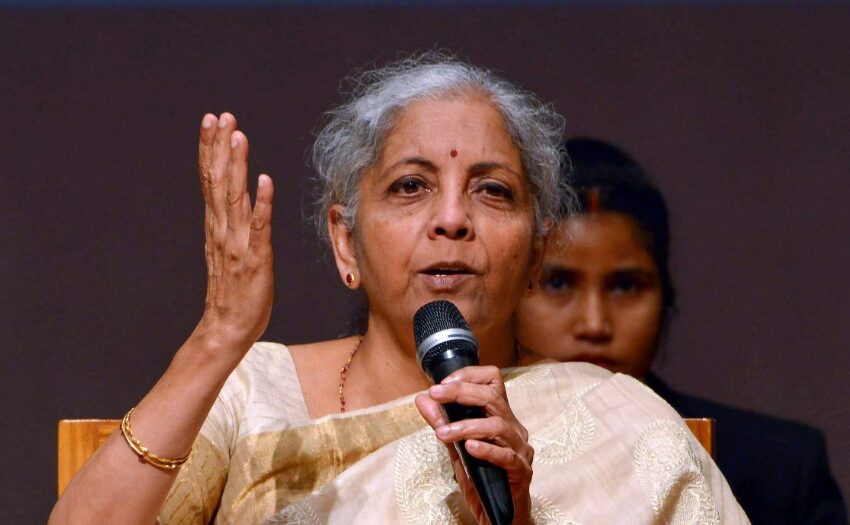
Nirmala Sitharaman cites inflation, job creation, says GDP growth dip is temporary blip
Amid growing concerns over India’s economic slowdown, Union finance minister Nirmala Sitharaman in the Lok Sabha on Tuesday termed the dip in GDP growth a “temporary blip” and projected confidence in a strong recovery.
She defended the government’s economic policies, citing controlled inflation, job creation and robust capital expenditure.
GDP growth: A temporary setback or a deeper problem?
Sitharaman acknowledged the 5.4 per cent GDP growth in Q2 as slower than expected, describing it as a “challenging quarter” influenced by global economic headwinds. But she emphasised India remains the fastest-growing major economy, with an average growth rate of 8.3 per cent over the past three years.
She expressed confidence growth would rebound in the coming quarters, attributing it to the resilience of the people and ongoing government initiatives.
“The real growth rate for Q1 and Q2 of this financial year (FY25) has been 6.7 per cent and 5.4 per cent, respectively. At 5.4 per cent, the Q2 rate is slower than expected…Q2 of this financial year has been a challenging quarter for India and most other economies of the world,” she said.
A week ago, Leader of Opposition Rahul Gandhi had described the slowdown as symptoms of an economy “benefiting only a handful of billionaires,” while most continue to struggle.
Congress leader Jairam Ramesh attributed the sluggish growth to stagnant wages, citing a report by India Ratings and Research that flagged weak consumption as a major concern.
Global agencies have also tempered their growth forecasts: Fitch Ratings has lowered India’s FY25 GDP estimate to 6.4 per cent, while Asian Development Bank and Morgan Stanley have revised theirs to 6.5 and 6.3 per cent respectively.
According to Fitch Ratings, weakened private consumption and muted investment suggest that the economic slowdown may not be temporar
Inflation: Controlled, yet costly for the poor
Sitharaman cited India’s success in keeping inflation under control, with retail inflation averaging 4.8 per cent between April and October 2024 — the lowest since the Covid pandemic. She pointed to core inflation — excluding food and fuel — which stood at a decade-low 3.6 per cent.
The Opposition had criticised the government for failing to address rising food and fuel prices. Trinamul MP Sougata Ray had argued that controlled headline inflation masks the hardship faced by ordinary citizens whose purchasing power continues to erode.
Economists, too, have warned that stagnant wages have offset the benefits of lower inflation, preventing a much-needed boost in household consumption.
Unemployment: Falling rates, rising questions
The finance minister spoke about a decline in the unemployment rate from 6 per cent in 2017-18 to 3.2 per cent now, attributing this improvement to the economic policies of the government and the capital expenditure. According to Sitharaman, increased investments in infrastructure and targeted schemes have helped generate employment and economic activity across sectors.
She said inflation was better controlled in the NDA regime whereas under the UPA it had touched double digits.
Opposition leaders had questioned the quality of jobs being created. Manish Tewari argued that much of the improvement is driven by low-paying, informal jobs that lack security and growth prospects.
A Reuters poll of economists, published in October 2024, cautioned key drivers such as job creation and household spending would only increase mildly over the next one year.
A closer look at employment trends reveals concerns over underemployment and stagnant real wages, which continue to limit economic mobility for millions. Critics warn that without substantial industrial growth and private sector participation, sustainable job creation will remain elusive.
Manufacturing: A sector in trouble
Sitharaman asserted that half of the sectors within the Index of Industrial Production (IIP) remain strong, dismissing concerns of a widespread manufacturing slowdown. She described the downturn as restricted to a few segments and iterated that capital expenditure would help revive the sector.
Leader of Opposition Rahul Gandhi had highlighted manufacturing’s share in GDP falling to a 50-year low of 13 percent calling it a “serious question mark” on job creation and industrial growth. Jairam Ramesh and other critics pointed to policy disruptions like demonetization and GST implementation as factors that weakened the sector.
Morgan Stanley and other agencies have flagged muted private investment and sluggish demand as key barriers.
The manufacturing sector serves as a backbone for job creation and broader economic growth.
Capital expenditure: The government’s growth anchor
In her Lok Sabha speech, Sitharaman placed significant emphasis on capital expenditure as a growth driver. She noted that the Union government’s capital expenditure increased by 6.4 per cent between July and October 2024.
She highlighted the allocation of Rs 11.11 lakh crore on this account this fiscal year, arguing that investments in infrastructure generate a multiplier effect of up to 4.3 times.
“I think steps that we are taking to push for growth and to sustain growth are going to this route of capital expenditure so that the multiplier effect will spread through the economy and therefore give a greater traction,” she said.
While capex remains a lifeline for growth, critics including Manish Tewari pointed out the risks of overreliance on government spending. Private investment, they argued, remains lacklustre with weak business confidence.
Analysts caution that while public expenditure can provide short-term momentum, sustainable growth requires a revival in private sector capex and consumption.


